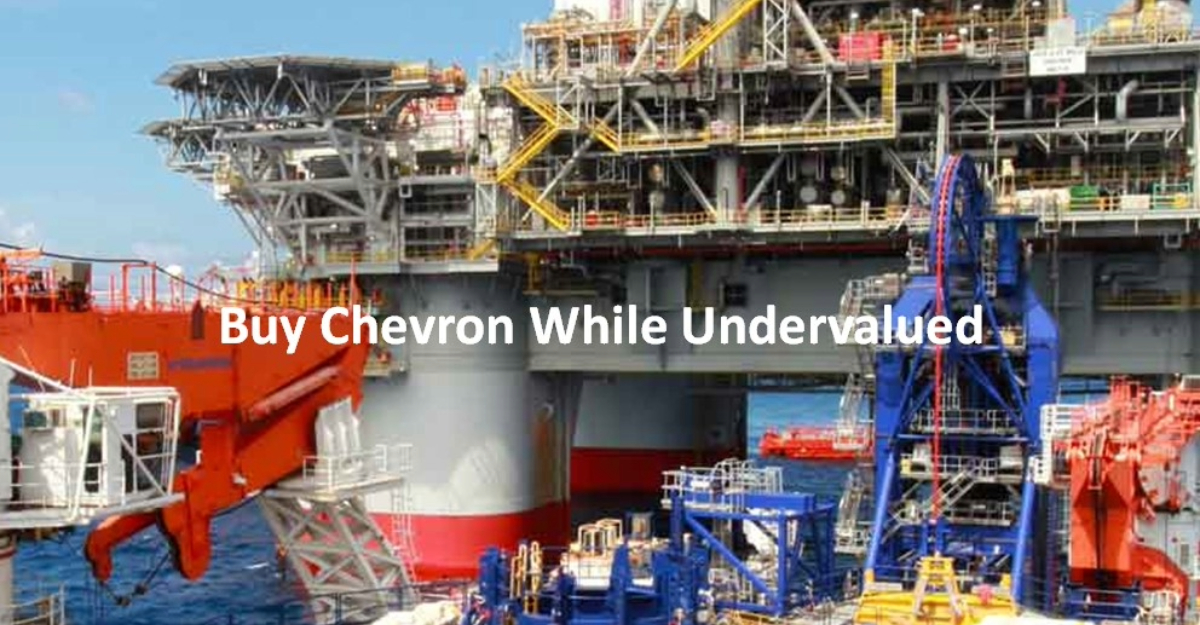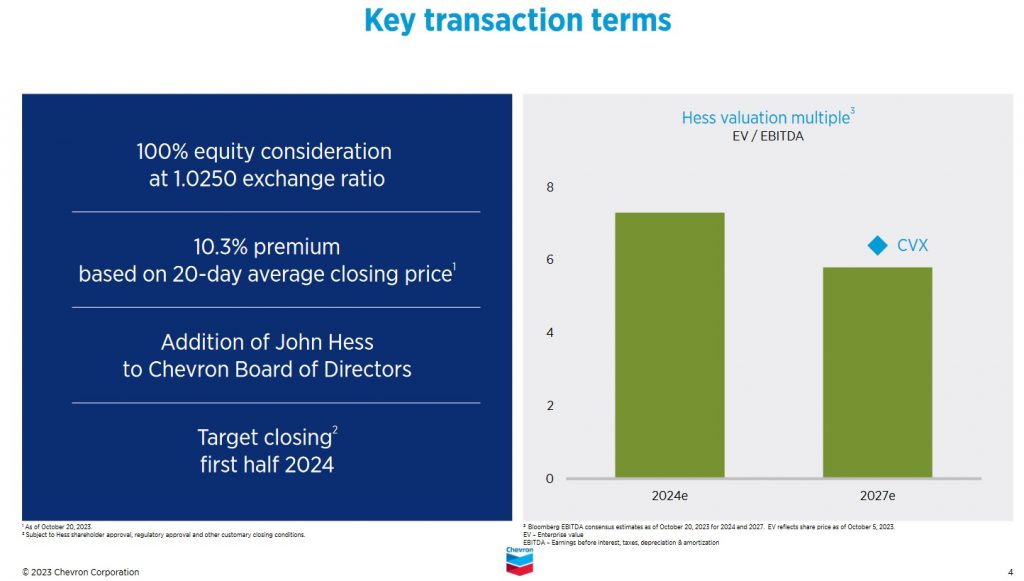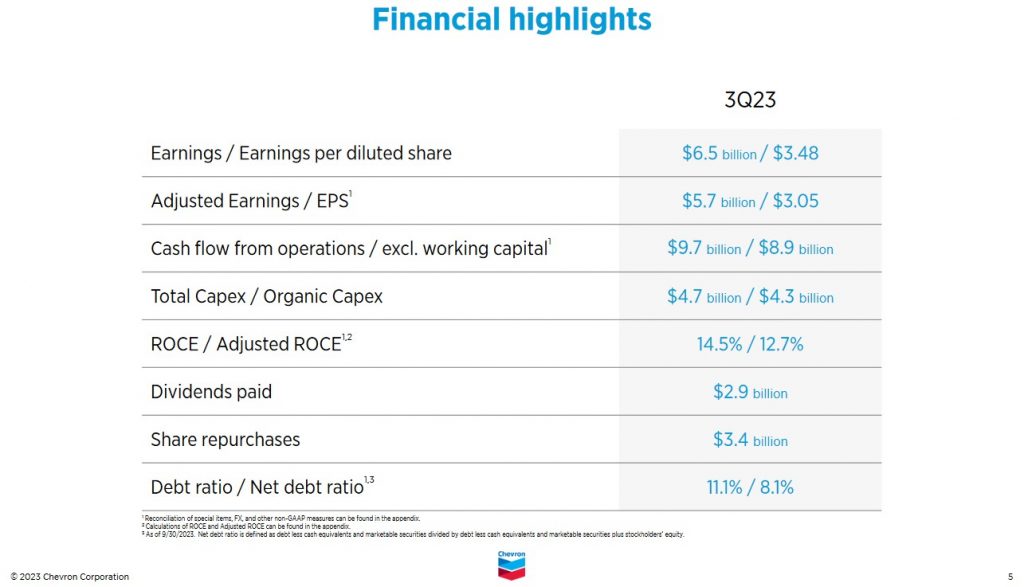Contents

Chevron's (CVX) share price has slid from its early November 2022 ~$190 peak to ~$147 following the release of its Q3 2023 report that showed rising expenses from overseas projects, most notably in Kazakhstan. The world, however, needs energy and CVX is positioning itself to play a key role in helping meet the world's future energy needs. Based on my analysis, buy Chevron while it is undervalued.
I last reviewed CVX in this July 30 post at which time the most current financial results were for Q2 2023. CVX had also recently entered into a definitive agreement with PDC Energy, Inc. (PDCE) to acquire all of the outstanding shares in an all-stock transaction valued at $6.3B, or $72/share; this purchase closed in early August 2023.
We now have CVX's Q3 and YTD2023 results. In addition, it recently announced its agreement to acquire all of the outstanding shares of Hess Corporation in an all-stock transaction valued at $53B, or $171/share based on CVX's closing price on October 20. The total enterprise value, including debt, is $60B.
Business Overview
You are undoubtedly familiar with CVX. If not, the 2022 Annual Report contains a wealth of information from which you can familiarize yourself with the company.
Abysmal Historical Performance
Before proceeding further, it is only fair to warn you that CVX's average annual total return over the past decade is an abysmal 6.18% and 4.78% with and without dividend reinvestment, respectively. Historically, CVX would spend years and billions of dollars on exploration and development and then billions more to develop a project. Major offshore projects would typically not generate any earnings or free cash flow for roughly a decade (or more). This is borne out from CVX's cash flow during the FY2013 - FY2022 timeframe.
- Operating Cash Flow (in Billions of $): 35, 31, 19, 13, 20, 31, 27, 11, 29, and 50;
- Capital Expenditures (in Billions of $): -37.99, -35.41, -29.50, -18.11, -13.40, -13.79, -14.12, -8.92, -8.06, and -11.97; and
- Free Cash Flow (in Billions of $): -2.98, -3.93, -10.05, -5.42, 6.93, 16.83, 13.20, 1.66, 21.13, and 37.63.
After years of investor frustration, CVX's leadership finally listened. In recent years, CVX has revamped the way it conducts business from a cash flow perspective. Now, it focuses on projects that will generate positive cash flow in a shorter timeframe. This has enabled CVX to increase how much it can return to shareholders in the form of dividends and share buybacks.
On the matter of buybacks, the weighted average shares outstanding will increase by reason of the shares issued to acquire PDC Energy and Hess. Below, however, I address the rationale for purchasing these companies with CVX shares and the speed at which CVX is repurchasing shares to address dilution concerns.
Hess Acquisition
Hess is an exploration and production company with ownership in the industry’s most attractive, long-lived growth asset in Guyana and a portfolio that complements CVX's.
CVX's leadership has identified $1B of run-rate cost synergies it expects to realize within a year of closing. The transaction is to become accretive to cash flow per share in 2025 after achieving synergies and start-up of the fourth floating production, storage and offloading vessel (FPSO) in Guyana.
Commodity prices can be quite volatile and the acquisition is slated to close in the first half of FY2024. If the purchase were to consist of a significant cash component, commodity prices could swing considerably higher or lower between now and closing. The use of equity for the purchase, however, locks in the exchange ratio. This essentially creates a hedge against commodity price movement.

In making the acquisition announcement, CVX indicated that it was buying back its shares at a rate of ~$17.5B/year meaning the shares being issued for the Hess acquisition should be repurchased in less than 2 quarters. This alleviates any concern shareholders may have about dilution.
Hess - High Return Growth Assets
The energy industry touts offshore Guyana as the largest oil discovery in the last 10 years.
Through its Hess purchase, CVX now has a 30% share in Guyana's offshore Stabroek block. Exxon Mobil (XOM) holds a 45% stake and China's CNOOC International holds a 25% interest in the project.
This area off Guyana's coast reports more than 11 billion barrels of oil equivalent (boe). Industry projections estimate that Guyana is expected to produce more than 1 million barrels per day (bpd) by 2026.
Currently, Hess' share of net production is ~110 thousand bpd at industry-leading cash margins with low carbon intensity. This volume is generated from two FPSOs. There are also 3 more FPSOs currently under development with the potential for up to 10 FPSOs. In addition, there is exploration upside potential, with 10 to 12 wells planned for 2024.
In the Bakken, Hess holds a strong acreage position with several future drilling locations that will be added to CVX's existing portfolio.
Hess’ assets in the Gulf of Mexico are complementary to Chevron’s existing assets.
In Southeast Asia, Hess' assets provide predictable financial performance from natural gas contracts with oil-linked pricing. CVX already has a long history in this region with a portfolio of advantaged gas positions in Australia.

More than 75% of CVX's upstream CAPEX is expected to be focused on the assets reflected above. This should position CVX to deliver durable free cash flow (FCF) growth into the next decade. With a stronger combined portfolio, CVX expects to further generate ~$10B - ~$15B in before-tax proceeds from asset sales through 2028.
Within the past ~4 years and following the closing of the Hess acquisition, CVX will have created new, significant reserves and resource positions in the DJ Basin, Eastern Mediterranean, Bakken and Guyana, building on its positions in Australia, Kazakhstan, Permian Basin and offshore Gulf of Mexico.
Financials
Q3 and YTD2023 Results
Material related to CVX's Q3 and YTD2023 earnings release is accessible here. The Q3 2023 Form 10-Q is accessible here.
The company's 8.1% Net Debt Ratio at the end of Q3 is higher than the 3.3% recorded at FYE2022. Nevertheless, this is still a conservative level of net debt.
The Return on Capital Employed (ROCE) has deteriorated relative to FYE2022. Investors, however, must remember that FY2022 was an immensely successful year making for a difficult YoY comparison.
Free Cash Flow (FCF)
In FY2018 - FY2022, CVX generated (in Billions of $) 16.83, 13.20, 1.66, 21.13, and 37.63. In the first 9 months of FY2023, it generated $15.888.
Expectations are for projected free cash flow (FCF) growth from investments in the western Kazakhstan steppe (TCO), Guyana, Permian and Gulf of Mexico and renewable fuels and petrochemical facilities to more than double by 2027.
Credit Ratings
The outlook for CVX's senior unsecured domestic currency debt ratings is stable; the ratings are the same as in my last post.
- Moody's: Aa2 (this is the middle tier of the high-grade investment-grade category).
- S&P Global: AA- (this is the bottom tier of the high-grade investment-grade category).
Both ratings define CVX as having a VERY STRONG capacity to meet its financial commitments. It differs from the highest-rated obligors only to a small degree.
Dividend and Dividend Yield
CVX's dividend history is accessible here.
The Board declared a quarterly dividend of $1.51/share payable December 11 to all holders of common stock as shown on the transfer records of the corporation at the close of business on November 17. This marks the 4th consecutive quarterly dividend at this rate.
When I wrote my July 30 post, I stated:
I think there is a reasonable probability CVX will increase the quarterly dividend to $1.60 when it declares its dividend in January 2024. Investors can likely expect the next 4 dividends to total $6.22 ((2 x $1.51) + (2 x $1.60)). Using this total and my recent purchase price, the forward dividend yield is ~4%.
With higher expected FCF growth, CVX intends to return more cash to shareholders. Over the past 5 years, the dividend per share has grown by a ~6% compounded annual growth rate. When CVX announced the Hess acquisition, management stated it expected to recommend an ~8% increase to its Q1 dividend per share to $1.63. This increase still requires Board approval.
With shares trading at ~$147.60 and the next 4 quarterly dividends likely to total $6.40 (($1.51 x 1) + ($1.63 x3)), the forward dividend yield is ~4.3%.
CVX's diluted weighted average shares outstanding in FY2011 - FY2022 (in millions) are 2,001, 1,965, 1,932, 1,884, 1,875, 1,873, 1,898, 1,914, 1,895, 1,870, 1,920, and 1,940. If we exclude 14 million shares outstanding that are associated with Chevron’s Benefit Plan Trust, there were 1,916 million and 1,901 million outstanding shares on December 31, 2021 and December 31, 2022, respectively.
In the first 9 months of FY2023, CVX has repurchased $11.281B of issued shares. The weighted average number of diluted shares outstanding in Q3 2023 was ~1,877.
On January 25, 2023, CVX announced that its Board authorized a new $75B share repurchase program (the '2023 Program') with no fixed expiration that took effect on April 1; the previous authorization was $25B. The plan is to steadily repurchase shares across commodity cycles. With a breakeven Brent price of around $50/barrel to cover CapEx and the dividend and with excess balance sheet capacity, CVX is positioned to return more cash to shareholders in any reasonable oil price scenario. Rather than the Board having to revisit the share repurchase authorization every few years, the repurchase authorization has been set where this matter does not need to be revisited as frequently.
CVX repurchased 48.0 million shares for $7.8B under the 2023 Program, including 20.7 million shares repurchased for $3.4B in Q3. In connection with the pending transaction with Hess, share repurchases are restricted pursuant to SEC regulations. CVX expects share repurchases in Q4 to be ~$3B (+/- 20%) depending primarily on the timing of the Hess definitive proxy statement mailing.
Valuation
CVX's FY2011 - FY2022 PE levels are 7.88, 8.12, 10.22, 10.33, 19.51, N/A, 36.50, 14.64, 17.29, N/A, 22.65, and 10.21. The years in which PE levels are N/A are when CVX reported a loss.
CVX's valuation at the time of prior posts is accessible in my January 28, 2023 post. I do, however, provide below CVX's valuation at the time of my prior two posts for ease of reference.
When I wrote my January 28, 2023 post, shares were trading at ~$179.60. CVX's forward-adjusted diluted PE levels using available broker estimates were:
- FY2023: ~11.3 using a mean of $15.96 and a low/high range of $12.53 - $20.94 from 28 brokers.
- FY2024: ~12.3 using a mean of $14.81 and a low/high range of $7.95 - $22.29 from 20 brokers.
- FY2025: ~14.7 using a mean of $12.18 and a low/high range of $9.28 - $13.54 from 7 brokers.
At the time of my July 30 post, I had recently acquired additional shares at $153.69. CVX's forward-adjusted diluted PE levels using available broker estimates were:
- FY2023: ~11.9 using a mean of $12.91 and a low/high range of $10.75 - $15.58 from 23 brokers.
- FY2024: ~11.2 using a mean of $13.74 and a low/high range of $10.90 - $18.95 from 23 brokers.
- FY2025: ~10.7 using a mean of $14.35 and a low/high range of $8.37 - $23.02 from 14 brokers.
Shares now trade at ~$147.60. CVX's forward-adjusted diluted PE levels using available broker estimates are:
- FY2023: ~11 using a mean of $13.51 and a low/high range of $12.82 - $14.33 from 16 brokers.
- FY2024: ~9.9 using a mean of $14.88 and a low/high range of $11.52 - $20.75 from 14 brokers.
- FY2025: ~9.6 using a mean of $15.36 and a low/high range of $12.07 - $20.51 from 10 brokers.
The range of estimates is wide and it appears not all brokers have provided their updated earnings estimates.
Trying to determine CVX's valuation based on earnings estimates over the next several years is extremely difficult. I have never determined how to forecast CVX's future earnings several years into the future considering commodity prices are unpredictable.
Final Thoughts
The Organization of the Petroleum Exporting Countries (OPEC) projects global oil demand will gradually rise by more than 16 million barrels per day over the next couple of decades, from 99.6 million in 2022 to 116 million in 2045.
The International Energy Agency's (IEA) 2023 medium-term oil market report forecasts global oil demand will rise by 6% from 2022 to 2028, reaching 105.7 million bpd. This increase will be supported by robust demand from the petrochemical and aviation sectors. However, it forecasts that demand for oil and natural gas will peak by 2030. This is due to electric vehicles, clean energy and slowing economic growth in China.
Not only do the IEA and OPEC also have difficulty in forecasting but so do independent forecasters and the U.S. Energy Information Administration.
Industry leaders such as CVX and XOM have made energy demand projections over the next 20 - 30 years. While their projections call for an increase in renewables and a decrease in fossil fuel demand, their outlook does not call for a massive reduction in fossil fuel demand.
Electric vehicle (EV) proponents warn that the demise of oil and gas companies is inevitable as EVs become increasingly popular. Unless radical changes are made in the EV space, I think this is an exaggeration. Powering your car should always be easy. EV charging, however, is a huge pain.
Interestingly, the Federal Reserve Bank of Dallas special question survey conducted in September received 142 responses from oil and gas firms. In response to the question 'How do you expect global oil consumption in 2050 to compare with current levels?', the findings were:
The percentage of executives who expect global oil consumption in 2050 to be higher when compared to current levels exceeds the percentage that expects it to be lower. Of the executives surveyed, 28 percent expect global oil consumption in 2050 to be slightly higher when compared to current levels, and an additional 25 percent expect it to be significantly higher. Meanwhile, 25 percent of executives expect consumption to be slightly lower in 2050 when compared to current levels, and an additional 8 percent expect it to be significantly lower. Fifteen percent expect global oil consumption in 2050 to be close to current levels.
There will certainly be industry consolidation in the coming years. However, the final thoughts I expressed in my July 30 CVX post are unchanged.
CVX's total shareholder return (with dividends reinvested) over the past 52 weeks is (~15.5%). Investors, however, should approach a CVX investment from a long-term perspective.
The share dilution resulting from the issuance of shares to acquire PDC Energy and Hess is a non-issue. CVX plans to repurchase shares at a rate of ~$17.5B/year meaning shares issued for the 2 acquisitions should be repurchased over a 3 - 5 quarters timeframe. Over the long term, I anticipate greater profitability and stronger FCF from CVX. The time to invest in CVX, therefore, is when shares are undervalued.
I currently hold 2,342 CVX shares within the FFJ Portfolio (1,342 and 668 shares in two different 'Core' accounts and 332 shares in a 'Side' account).
Despite CVX being undervalued, I am satisfied with my current exposure. I will, however, continue to increase my exposure by automatically reinvesting the quarterly dividend income.
I wish you much success on your journey to financial freedom!
Note: Please send any feedback, corrections, or questions to [email protected].
Disclosure: I am long CVX and XOM.
Disclaimer: I do not know your circumstances and am not providing individualized advice or recommendations. I encourage you not to make any investment decisions without conducting your research and due diligence. You should also consult your financial advisor about your specific situation.
I wrote this article myself and it expresses my own opinions. I am not receiving compensation for it and have no business relationship with any company whose stock is mentioned in this article.



